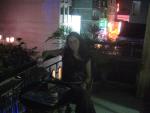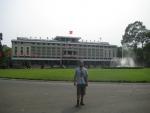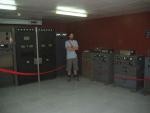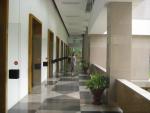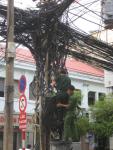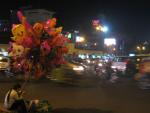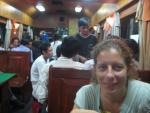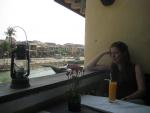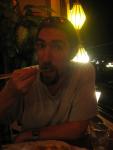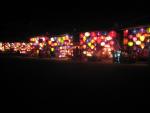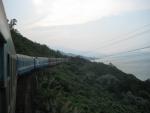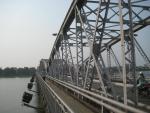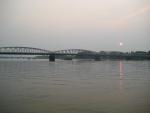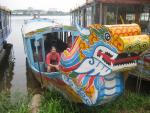Skipping through South Vietnam
Tue 6th Apr 2010 — drew
We spent a very pleasant few days in Saigon, enjoying our relatively expensive hotel room and cheap beer! Getting around the city took a bit of getting used to - in contrast to the cool, efficient public transport systems in places like KL and Singapore, Vietnamese cities seem to be totally ruled by the motorbike. Everywhere tourists walk they are shouted offers of rides by motorbike taxi (even when laden with a huge rucksack), and crossing the road is pretty much a matter of fighting the instinct to wait for the gap in the traffic (which will never come, even on a zebra crossing with a green man) and trusting that if you start walking, the traffic will swerve to avoid you.
There's a long list of museums in Saigon and we made it to a few. Our first stop was the Reunification Palace, which was designed and built in the early 60's. It is like a palace of authentic retro kitsch especially as the inside has not been changed or disturbed since April 1975 when the communist tanks burst through the iron gates and symbolically raised the flag of the yellow star. It is a bit like an Austin Powers / James Bond villain's lair with a network of underground tunnels filled with tactical maps and dial-laden analogue communications equipment. Upstairs are all the usual rooms that you would expect in a palace but in delightful 60s style; conference rooms with oval tables and microphones on bendy booms, reception and dining rooms with amazing furniture and decorations, and on the top floor both a cinema and gambling room, which were among our favourites.
Next was the War Remnants Museum, which was somewhat harrowing. It was very interesting to see exhibits about what is referred to here as the American War giving the opposite point-of-view to the vast majority of films and TV programmes we've grown up with. The museum certainly pulls no punches, and our relatively brief visit was quite sobering after the kitsch 60s palace. We also made it to the Fine Art museum, which we think it's fair to say was dominated by pictures of rural Vietnamese people carrying rifles. It seemed a bit strange that some of the larger show-pieces depicting war-time situations were fairly recent - many from the 90s. The fact that by 1975 when the American troops left and North and South were unified, the country had been at war for roughly a century probably goes some way to explaining this recurring theme.
We were only there a couple of days, but on our last night we were happy to meet up with one of Drew's friends from his old work who is now living in Saigon. The next day we took a train heading North up to Danang. We had a slight moment of concern when our hotel arranged a taxi to the station for us, and somehow managed to tell the taxi driver to take us to the airport. We realised what had gone wrong just in time, and managed to get the message across to the agitated driver despite almost no shared language. Once he had stopped cursing, he did a great job at navigating the rush hour traffic and got us to the train station with a few minutes to spare.
It was our first overnight train journey for a while and we were not sure what Vietnamese trains would be like. We did not need to worry though as our soft sleeper tickets got us a pleasant 4-bed berth comprising two bunk-beds. It seems that most tourists travel on open bus tickets and our companions in the berth were quite visibly surprised to find they were sharing with foreigners. At first it seemed like they spoke almost no English, but as the evening progressed, we found out that the husband had been a student in Miami in 1969; he told us he'd not used his English since then, but as we shared a few beers it seemed to come back to him, and we had a very convivial journey. We weren't sure how much to press him for details, but it was obviously a interesting time to have been a Vietnamese student in the USA. His wife didn't speak English but chimed in several times via her husband's translations; the most memorable of which being that she thought Drew looked like Jesus Christ! It was good to hear them speak very positively about present-day Vietnam and their hopes for the country's future.
Having had a comfortable night's rest, we arrived in Danang around mid-day. From here it was a short ride to the quaint old port of Hoi An. The picturesque old town area is characterised by narrow lanes of squat buildings with open shop fronts and a pleasant riverfront, with strings of colourful lanterns everywhere. Nowadays, this is more of a tourist trap than our last few stops with an amazing proportion of the shops being tailors turning out fitted suits and dresses. Even so, it was a nice place to spend a quiet couple of days which we were certainly in need of having covered a fair bit of ground through a number of countries in the past few weeks. It also provided a very romantic location to celebrate our 6th wedding anniversary overlooking the lights on the river and sampling some local delicacies.
We got back on the train in Danang for a spectacular trip up the coast (looking out to the South China Sea) which wound its ways betwixt countless beautiful bays and lush green mountains en route to Hue, only a couple of hours north. Hue is situated on the 'perfume river' and is a former capital of Vietnam with an impressive crumbling citadel and ancient tombs dating back to the 18th century. It is very close to what was the demilitarized zone (DMZ) although there is very little evidence of this being the scene of intense fighting more than three decades ago unless you go on one of the tours, which we chose not to. War tourism seems a little odd; there is no doubting the historical (or perhaps family) interest, but it seems a bit ghoulish when you see pictures of tourists brandishing M16s or AK47s in Rambo poses to advertise the tours.
We had heard that the mountains we passed between Danang and Hue formed a climatic border between the north and south of the country and were hoping for some cooler temperatures; however, this does not appear to be the case at present. The temperature seems to be hovering around 30 - 35 degrees C, but we have both been suffering from the effects of high humidity which makes you pour with sweat to the extent that it's hard to stay hydrated. Short walks seem far more exhausting than they should, and we could easily change through all the clothes we have with us in one day. However, we'd better get used to it as we're heading over the border into Laos tomorrow, so are leaving any coastal breezes behind. The BBC weather website has a helpful table illustrating the typical climate in Vientiane which predicts "extreme discomfort from heat and humidity" at this time of year. Looks like we need to keep gulping the water down for a few more weeks.
- ‹ previous
- 61 of 70
- next ›

